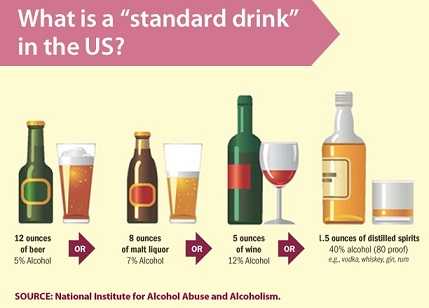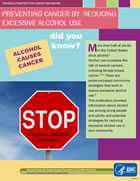Policies and Practices for Cancer Prevention: Reducing Excessive Alcohol Use
More than half of adults in the United States drink alcohol.1 Alcohol use increases the risk of several cancers, including female breast cancer.2,3,4 There are evidence-based community strategies that work to reduce excessive alcohol use.5 This publication provides information about alcohol use among young people and adults and potential strategies for reducing excessive alcohol use in your community.
Cancer Risks Linked with Alcohol Use
Excessive alcohol use is associated with many health and social problems. Alcohol is a carcinogen (something that can cause cancer) and can contribute to the development of cancers of the female breast, liver, colon, rectum, mouth, pharynx, larynx, and esophagus.2,3,4 Regardless of drink type (beer, wine, or liquor), the risk of cancer increases with the number of drinks consumed, and even one drink a day increases the risk of developing cancers of the female breast, mouth, and esophagus.3 Reducing alcohol use may reduce the risk of cancer.6
Box 1. How Is Alcohol Use Defined?
Moderate alcohol use is defined as consuming up to one drink per day for women and up to two drinks per day for men.
Excessive alcohol use includes binge drinking, heavy drinking, any alcohol use by individuals under the age of 21 years (minimum legal drinking age), and any alcohol use by pregnant women.
Binge drinking is a pattern of alcohol use that brings blood alcohol concentration levels to 0.08% or more. This is usually defined as consuming four drinks or more for women and five drinks or more for men on a single occasion, generally within about two hours.
Heavy drinking is defined as consuming eight drinks or more per week for women and 15 drinks or more per week for men.
Source: Frequently Asked Questions About Alcohol and Public Health

Alcohol Use Among Adults
Alcohol use is one of the most common risk factors for cancer among adults in the United States.1
- 56% of adults drink alcohol.
- 67% of adult drinkers exceed guidelines for moderate alcohol use.7
- 17% of adults binge drink.
- 6% of adults are heavy drinkers.
Alcohol Use Among Young People
While the legal age for drinking alcohol is 21 years, drinking alcohol is common among young people in the United States.8
- 35% of high school students drink alcohol.
- 21% of high school students have had five or more alcoholic drinks on a single occasion (in other words, reported binge drinking).
Box 2. What Are the Guidelines for Alcohol Use?
According to the Dietary Guidelines for Americans, 2010 9—
- Don’t start drinking or increase the amount you drink on the basis of potential health benefits. Even moderate intake is associated with increased risks, including some cancers.
- If you choose to drink, do so in moderation—up to one drink a day for women or up to two drinks a day for men.
- Don’t drink at all if you are under age 21, pregnant or may be pregnant, have health problems that could be made worse by drinking, or are engaging in activities for which alcohol is dangerous (like driving).
Cancer and Alcohol Infographic

Drinking alcohol raises the risk of some cancers. Drinking any kind of alcohol can contribute to cancers of the mouth and throat, larynx (voice box), esophagus, colon and rectum, liver, and breast (in women). The less alcohol you drink, the lower the risk of cancer.
- Page last reviewed: August 10, 2015
- Page last updated: November 16, 2015
- Content source:
- Maintained By:


 ShareCompartir
ShareCompartir
